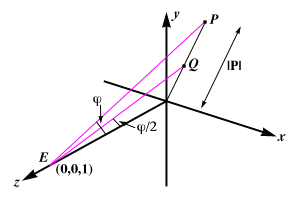
These homework exercises are simple questions designed to test your understanding of the lecture material. You are strongly advised to complete these exercises. Some sample answers will be provided during the lectures.
1. Explain what is meant by the following terms with respect to Matrices:
i) Orthogonal
ii) Inverse
iii)Transpose
iv) Row Vector
2. Given a matrix, M: if MT = M-1, what does this signify? What does this mean in terms of affine transforms?
3. Express as single 3 x 3 matrix the transformation required to transform points according to the following individual steps in 2D space:
Translation in x by 5.4 units, rotation by 45 degrees, translation in y by -5.4 units.
4. Draw the results of the transformations above (at each intermediate stage) as applied to a unit square that originally is centred on the origin.
5. What is meant by the term 'field of view' with respect to the synthetic camera model? Derive the formula that relates field of view to the distance of the focal point to the projection plane (d), and the projection window coordinates (Wl, Wr, Wt, Wb).
6. Derive a transformation for the 2D 'fish-eye' lens (basically an 'angle-halver'): (Refer to the diagram below) Any point P on the x-y plane is mapped onto Q, situated along the line OP but closer to the origin, O. Q is thus just a scaled version of P: Q = sP. To determine s, imagine a point E at unit distance along the z-axis, and note the angle [[phi]] subtended at E by OP. What is the formula that relates s to P? Is this transformation affine?

7. Given a point P = (x,y,z) in world co-ordinates, a View Reference Point (VRP), r, and a u,v,n viewing co-ordinate axes, the point P relative to the viewing co-ordinates (a,b,c) can be expressed:
(a,b,c) = (p - r)M-1
i) What is the value of the matrix M?
ii) Show that :
a = (p - r) . u
b = (p - r) . v
c = (p - r) . n
8. Explain the difference between Phong interpolation and Phong shading.
9. Describe a lighting model which includes ambient, diffuse and specular reflections with light sources infinitely far away from the viewer (ie. they only have a direction). How does the number of lights affect each of the illumination components?
10. Most hidden surface removal algorithms can be classified as operating in object space or image space. Describe two algorithms for removing hidden surfaces - one that operates in image space and another that operates in object space.
11. For the two algorithms you described above, compare and discuss their efficiency with respect to the following:
(i) A large number of primitives
(ii) Memory usage
(iii) Sorting operations
(iv) Concave polygons
(v) Transparency